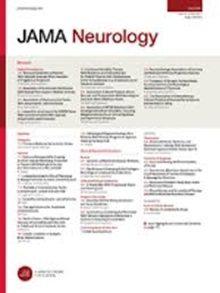Menopause Impact on Multiple Sclerosis Disability Progression.
IF 21.3
1区 医学
Q1 CLINICAL NEUROLOGY
引用次数: 0
Abstract
Importance Most women with multiple sclerosis (MS) will experience menopause while living with MS. Despite this, the impact of menopause on MS disease trajectory remains unclear. Objective To assess whether menopause modifies the risk of disability progression for women with relapse-onset MS. Design, Setting, and Participants This retrospective cohort study used prospective clinical data that were collected within the MSBase Registry. Data were extracted from MSBase on July 1, 2023. These data were analyzed from January 2023 through February 2025. Female participants were recruited from 8 Australian neuroimmunology specialist centers (1 private practice and 7 tertiary referral centers) from 2018 through 2021. Participants included 1468 women aged 18 years or older who completed dedicated retrospective women's health surveys. Of these, 987 women with relapse-onset MS, 3 or more Expanded Disability Status Scale (EDSS) measurements recorded, and reported menopausal status were included in the primary analysis. The secondary analysis included 209 women with 1 or more EDSS measurements recorded in the MSBase database predate and postdate of menopause onset. Exposure Crude and adjusted Cox proportional hazards models were used to assess the impact of menopause, modeled as a time-varying covariate, on progressive disability milestones. Analyses were adjusted for age at MS onset, baseline disease duration, baseline EDSS score, baseline relapse, and exposure to high-efficacy disease-modifying therapy modeled as a time-varying covariate. Main Outcome Measures In the primary analysis, the main outcome was time to 6-month confirmed disability progression (CDP). The secondary outcome was time to secondary progressive MS (SPMS). The secondary inflection point analysis examined longitudinal changes in EDSS in women who were followed up with throughout their menopausal transition. Results Primary analysis included 583 premenopausal and 404 postmenopausal women with MS. The median age at menopause was 48.5 years. Following multivariable adjustment, menopause was not associated with an increased risk of CDP or SPMS (hazard ratio, 0.95; 95% CI, 0.70-1.29; P = .70 and hazard ratio, 1.00; 95% CI, 0.60-1.67; P = 1.00), respectively. In the secondary analysis, menopause did not represent an inflection point in EDSS worsening following multivariable adjustment. Conclusions and Relevance While reproductive aging may be additive to the effects of somatic aging, these results do not support menopause as the leading factor for disability progression in older women with MS.更年期对多发性硬化残疾进展的影响。
大多数患有多发性硬化症(MS)的女性在患有MS的同时会经历更年期,尽管如此,更年期对MS疾病轨迹的影响尚不清楚。目的评估绝经是否会改变复发性多发性硬化妇女残疾进展的风险。设计、环境和参与者本回顾性队列研究使用了MSBase Registry中收集的前瞻性临床数据。数据取自MSBase,时间为2023年7月1日。这些数据是从2023年1月到2025年2月进行分析的。女性参与者从2018年至2021年从8个澳大利亚神经免疫学专家中心(1个私人诊所和7个三级转诊中心)招募。参与者包括1468名年龄在18岁或以上的女性,她们完成了专门的回顾性女性健康调查。其中,987名复发性多发性硬化症女性,3次或以上的扩展残疾状态量表(EDSS)测量记录,并报告绝经状态被纳入主要分析。二次分析包括209名妇女,她们在绝经前和绝经后在MSBase数据库中记录了1次或1次以上的EDSS测量。我们使用了粗鲁和调整后的Cox比例风险模型来评估绝经对进行性残疾里程碑的影响,并将其建模为随时间变化的协变量。对MS发病年龄、基线疾病持续时间、基线EDSS评分、基线复发和暴露于作为时变协变量建模的高效疾病改善治疗进行调整分析。主要结局指标在主要分析中,主要结局指标为6个月确认的残疾进展(CDP)。次要终点是到继发性进展性MS (SPMS)的时间。次要拐点分析检查了在整个绝经过渡期间随访的妇女的EDSS的纵向变化。结果初步分析纳入583例绝经前ms患者和404例绝经后ms患者,绝经年龄中位数为48.5岁。经多变量调整后,绝经与CDP或SPMS的风险增加无关(风险比,0.95;95% CI, 0.70-1.29; P =。70,风险比1.00;95% ci, 0.60-1.67;P = 1.00)。在二次分析中,绝经并不代表多变量调整后EDSS恶化的拐点。结论和相关性虽然生殖衰老可能是躯体衰老的累加性影响,但这些结果并不支持更年期是老年MS妇女残疾进展的主要因素。
本文章由计算机程序翻译,如有差异,请以英文原文为准。
求助全文
约1分钟内获得全文
求助全文
来源期刊

JAMA neurology
CLINICAL NEUROLOGY-
CiteScore
41.90
自引率
1.70%
发文量
250
期刊介绍:
JAMA Neurology is an international peer-reviewed journal for physicians caring for people with neurologic disorders and those interested in the structure and function of the normal and diseased nervous system. The Archives of Neurology & Psychiatry began publication in 1919 and, in 1959, became 2 separate journals: Archives of Neurology and Archives of General Psychiatry. In 2013, their names changed to JAMA Neurology and JAMA Psychiatry, respectively. JAMA Neurology is a member of the JAMA Network, a consortium of peer-reviewed, general medical and specialty publications.
 求助内容:
求助内容: 应助结果提醒方式:
应助结果提醒方式:


